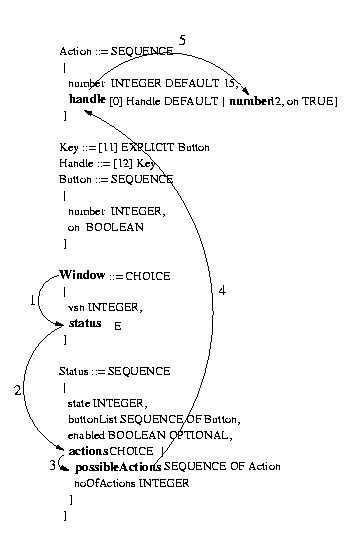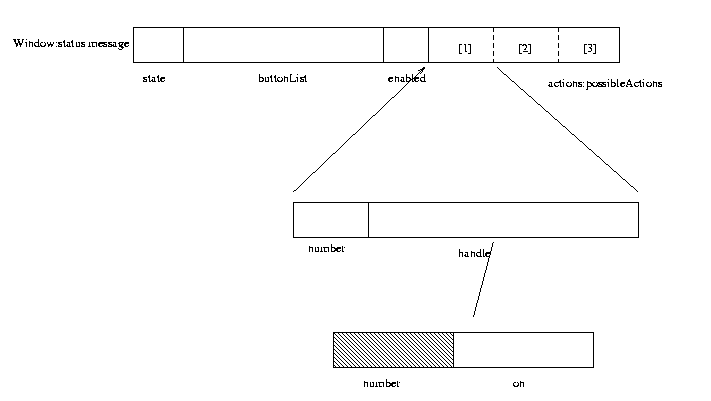View Source Specialized Decodes
When performance is of highest priority and one is interested in a limited part of the ASN.1 encoded message before deciding what to do with the rest of it, an option is to decode only a part of the message. This situation can be a server that has to decide the addressee of a message. The addressee can be interested in the entire message, but the server can be a bottleneck that you want to spare any unnecessary load.
Instead of making two complete decodes (the normal case of decode), one in the server and one in the addressee, it is only necessary to make one specialized decode (in the server) and another complete decode (in the addressee). This section describes the following specialized decode functionality:
- Exclusive decode
- Selected decode
This functionality is only provided when using BER (option ber).
Exclusive Decode
The basic idea with exclusive decode is to specify which parts of the message
you want to exclude from being decoded. These parts remain encoded and are
returned in the value structure as binaries. The undecoded parts can be decoded
later by calling the decode_part/2 function.
Procedure
To perform an exclusive decode:
Step 1: Decide the name of the function for the exclusive decode.
Step 2: Include the following instructions in a configuration file:
- The name of the exclusive decode function
- The name of the ASN.1 specification
- A notation that tells which parts of the message structure to be excluded from decode
Step 3 Compile with the additional option
asn1config. The compiler searches for a configuration file with the same name as the ASN.1 specification but with extension.asn1config. This configuration file is not the same as used for compilation of a set of files. See section Writing an Exclusive Decode Instruction.
User Interface
The runtime user interface for exclusive decode comprises the following two functions:
- A function for an exclusive decode, whose name the user decides in the configuration file
- A
decode_part/2function generated by the ASN.1 compiler when exclusive decode is enabled. This function decodes the parts that were left undecoded during the exclusive decode.
Both functions are described in the following.
If the exclusive decode function has, for example, the name decode_exclusive
and an ASN.1 encoded message Bin is to be exclusive decoded, the call is as
follows:
{ok,ExclMessage} = 'MyModule':decode_exclusive(Bin) The result ExclMessage has the same structure as a
complete decode would have, except for the parts of the top type that were not
decoded. The undecoded parts are on their places in the structure on format
{TypeKey,UndecodedValue}.
Each undecoded part that is to be decoded must be fed into function
decode_part/2 as follows:
{ok,PartMessage} = 'MyModule':decode_part(TypeKey, UndecodedValue)Writing an Exclusive Decode Instruction
This instruction is written in the configuration file in the following format:
ExclusiveDecodeInstruction = {exclusive_decode,{ModuleName,DecodeInstructions}}.
ModuleName = atom()
DecodeInstructions = [DecodeInstruction]+
DecodeInstruction = {ExclusiveDecodeFunctionName,TypeList}
ExclusiveDecodeFunctionName = atom()
TypeList = [TopType,ElementList]
ElementList = [Element]+
Element = {Name,parts} |
{Name,undecoded} |
{Name,ElementList}
TopType = atom()
Name = atom()The instruction must be a valid Erlang term terminated by a dot.
In TypeList the path from the top type to each undecoded subcomponent is
described. TopType is the name of a top-level type in the ASN.1 specification.
The action for each component in ElementList is described by one of:
{Name,parts}{Name,undecoded}{Name,ElementList}
The use and effect of the actions are as follows:
{Name,undecoded}- Leaves the element undecoded. The type ofNamecan be any ASN.1 type. The value of elementNameis returned as a tuple (as mentioned in the previous section) in the value structure of the top type.{Name,parts}- The type ofNamemust be eitherSEQUENCE OForSET OF. The action implies that the different components ofNameare left undecoded. The value ofNameis returned as a tuple (as mentioned in the previous section) where the second element is a list of binaries. This is because the representation of aSEQUENCE OFor aSET OFin Erlang is a list of its internal type. Any of the elements in this list or the entire list can be decoded by functiondecodepart.{Name,ElementList}- This action is used when one or more of the subtypes ofNameis exclusively decoded.
Name in these actions can be a component name of a SEQUENCE OF or a
SET OF, or a name of an alternative in a CHOICE.
Example
In this examples, the definitions from the following ASN.1 specification are used:
GUI DEFINITIONS AUTOMATIC TAGS ::= BEGIN
Action ::= SEQUENCE {
number INTEGER DEFAULT 15,
handle Handle DEFAULT {number 12, on TRUE}
}
Key ::= Button
Handle ::= Key
Button ::= SEQUENCE {
number INTEGER,
on BOOLEAN
}
Window ::= CHOICE {
vsn INTEGER,
status Status
}
Status ::= SEQUENCE {
state INTEGER,
buttonList SEQUENCE OF Button,
enabled BOOLEAN OPTIONAL,
actions CHOICE {
possibleActions SEQUENCE OF Action,
noOfActions INTEGER
}
}
ENDIf Button is a top type and it is needed to exclude component number from
decode, TypeList in the instruction in the configuration file is
['Button',[{number,undecoded}]]. If you call the decode function
decode_Button_exclusive, DecodeInstruction is
{decode_Button_exclusive,['Button',[{number,undecoded}]]}.
Another top type is Window whose subcomponent actions in type Status and the
parts of component buttonList are to be left undecoded. For this type, the
function is named decode__Window_exclusive. The complete
Exclusive_Decode_Instruction configuration is as follows:
{exclusive_decode,
{'GUI',
[{decode_Window_exclusive,
['Window',[{status,[{buttonList,parts},{actions,undecoded}]}]]},
{decode_Button_exclusive,
['Button',[{number,undecoded}]]}]}}.The following figure shows the bytes of a Window:status message. The
components buttonList and actions are excluded from decode. Only state and
enabled are decoded when decode__Window_exclusive is called.

Here follows an example of how the module. Note that option no_ok_wrapper is
used to make the example more concise.
1> asn1ct:compile('GUI', [ber,asn1config,no_ok_wrapper]).
ok
2> rr('GUI').
['Action','Button','Status']
3> ButtonMsg = #'Button'{number=123,on=true}.
#'Button'{number = 123,on = true}
4> ButtonBytes = 'GUI':encode('Button', ButtonMsg).
<<48,6,128,1,123,129,1,255>>
5> ExclusiveMsgButton = 'GUI':decode_Button_exclusive(ButtonBytes).
#'Button'{number = {'Button_number',<<128,1,123>>},
on = true}
6> {UndecKey,UndecBytes} = ExclusiveMsgButton#'Button'.number.
{'Button_number',<<128,1,123>>}
7> 'GUI':decode_part(UndecKey, UndecBytes).
123
8> WindowMsg =
{status,{'Status',35,
[{'Button',3,true},
{'Button',4,false},
{'Button',5,true},
{'Button',6,true},
{'Button',7,false}],
false,
{possibleActions,[{'Action',16,{'Button',17,true}}]}}}.
{status,#'Status'{state = 35,
buttonList = [#'Button'{number = 3,on = true},
#'Button'{number = 4,on = false},
#'Button'{number = 5,on = true},
#'Button'{number = 6,on = true},
#'Button'{number = 7,on = false}],
enabled = false,
actions = {possibleActions,[#'Action'{number = 16,
handle = #'Button'{number = 17,on = true}}]}}}
9> WindowBytes = 'GUI':encode('Window', WindowMsg).
<<161,65,128,1,35,161,40,48,6,128,1,3,129,1,255,48,6,128,
1,4,129,1,0,48,6,128,1,5,129,...>>
10> {status,#'Status'{buttonList={UndecWindowKey,UndecWindowParts}}} =
'GUI':decode_Window_exclusive(WindowBytes).
{status,#'Status'{state = 35,
buttonList = {'Status_buttonList',[<<48,6,128,1,3,129,1,
255>>,
<<48,6,128,1,4,129,1,0>>,
<<48,6,128,1,5,129,1,255>>,
<<48,6,128,1,6,129,1,255>>,
<<48,6,128,1,7,129,1,0>>]},
enabled = false,
actions = {'Status_actions',<<163,15,160,13,48,11,128,
1,16,161,6,128,1,17,129,
1,255>>}}}
11> 'GUI':decode_part(UndecWindowKey, UndecWindowParts).
[#'Button'{number = 3,on = true},
#'Button'{number = 4,on = false},
#'Button'{number = 5,on = true},
#'Button'{number = 6,on = true},
#'Button'{number = 7,on = false}]
12> 'GUI':decode_part(UndecWindowKey, hd(UndecWindowParts)).
#'Button'{number = 3,on = true}
13> {status,#'Status'{actions={ChoiceKey,ChoiceUndec}}} = v(10).
{status,#'Status'{state = 35,
buttonList = {'Status_buttonList',[<<48,6,128,1,3,129,1,
255>>,
<<48,6,128,1,4,129,1,0>>,
<<48,6,128,1,5,129,1,255>>,
<<48,6,128,1,6,129,1,255>>,
<<48,6,128,1,7,129,1,0>>]},
enabled = false,
actions = {'Status_actions',<<163,15,160,13,48,11,128,
1,16,161,6,128,1,17,129,
1,255>>}}}
14> 'GUI':decode_part(ChoiceKey, ChoiceUndec).
{possibleActions,[#'Action'{number = 16,
handle = #'Button'{number = 17,on = true}}]}Selective Decode
Selective decode decodes a single subtype of a constructed value. This is the fastest method to extract a subvalue. Selective decode is typically used when one want to inspect, for example, a version number to be able to decide how to handle the entire value.
Procedure
To perform a selective decode:
Step 1: Include the following instructions in the configuration file:
- The name of the user function
- The name of the ASN.1 specification
- A notation that tells which part of the type to be decoded
Step 2: Compile with the additional option
asn1config. The compiler searches for a configuration file with the same name as the ASN.1 specification, but with extension.asn1config. In the same file you can also provide configuration specifications for exclusive decode. The generated Erlang module has the usual functionality for encode/decode preserved and the specialized decode functionality added.
User Interface
The only new user interface function is the one provided by the user in the configuration file.
For example, if the configuration file includes the specification
{selective_decode,{'ModuleName',[{selected_decode_Window,TypeList}]}} do the
selective decode by
{ok,Result} = 'ModuleName':selected_decode_Window(EncodedBinary).
Writing a Selective Decode Instruction
One or more selective decode functions can be described in a configuration file. Use the following notation:
SelectiveDecodeInstruction = {selective_decode,{ModuleName,DecodeInstructions}}.
ModuleName = atom()
DecodeInstructions = [DecodeInstruction]+
DecodeInstruction = {SelectiveDecodeFunctionName,TypeList}
SelectiveDecodeFunctionName = atom()
TypeList = [TopType|ElementList]
ElementList = Name|ListSelector
Name = atom()
ListSelector = [integer()]The instruction must be a valid Erlang term terminated by a dot.
ModuleNameis the same as the name of the ASN.1 specification, but without the extension.DecodeInstructionis a tuple with your chosen function name and the components from the top type that leads to the single type you want to decode. Make sure to choose a name of your function that is not the same as any of the generated functions.- The first element of
TypeListis the top type of the encoded message. InElementList, it is followed by each of the component names that leads to selected type. - Each name in
ElementListmust be a constructed type except the last name, which can be any type. ListSelectormakes it possible to choose one of the encoded components in aSEQUENCE OFor aSET OF. It is also possible to go further in that component and pick a subtype of that to decode. So, in theTypeList:['Window',status,buttonList,[1],number], componentbuttonListmust be of typeSEQUENCE OForSET OF.
In the example, component number of the first of the encoded elements in the
SEQUENCE OF buttonList is selected. This applies on the ASN.1 specification
in section Writing an Exclusive Decode Instruction.
Example
In this example, the same ASN.1 specification as in section Writing an Exclusive Decode Instruction is used. The following is a valid selective decode instruction:
{selective_decode,
{'GUI',
[{selected_decode_Window1,
['Window',status,buttonList,
[1],
number]},
{selected_decode_Action,
['Action',handle,number]},
{selected_decode_Window2,
['Window',
status,
actions,
possibleActions,
[1],
handle,number]}]}}.The first instruction,
{selected_decode_Window1,['Window',status,buttonList,[1],number]} is described
in the previous section.
The second instruction, {selected_decode_Action,['Action',handle,number]},
takes component number in the handle component of type Action. If the
value is ValAction = {'Action',17,{'Button',4711,false}}, the internal value
4711 is to be picked by selected_decode_Action. In an Erlang terminal it looks
as follows:
1> asn1ct:compile('GUI', [ber,asn1config,no_ok_wrapper]).
ok
2> ValAction = {'Action',17,{'Button',4711,false}}.
{'Action',17,{'Button',4711,false}}
3> Bytes = 'GUI':encode('Action',ValAction).
<<48,18,2,1,17,160,13,172,11,171,9,48,7,128,2,18,103,129,1,0>>
4> 'GUI':selected_decode_Action(Bytes).
4711The third instruction,
['Window',status,actions,possibleActions,[1],handle,number], works as follows:
- Step 1: Starts with type
Window. - Step 2: Takes component
statusofWindowthat is of typeStatus. - Step 3: Takes actions of type
Status. - Step 4: Takes
possibleActionsof the internally definedCHOICEtype. - Step 5: Goes into the first component of
SEQUENCE OFby[1]. That component is of typeAction. - Step 6: Takes component
handle. - Step 7: Takes component
numberof typeButton.
The following figure shows which components are in TypeList
['Window',status,actions,possibleActions,[1],handle,number]:

In the following figure, only the marked element is decoded by
selected_decode_Window2:

With the following example, you can examine that both selected_decode_Window2
and selected_decode_Window1 decodes the intended subvalue of value Val:
1> Val = {status,{'Status',12,
[{'Button',13,true},
{'Button',14,false},
{'Button',15,true},
{'Button',16,false}],
true,
{possibleActions,[{'Action',17,{'Button',18,false}},
{'Action',19,{'Button',20,true}},
{'Action',21,{'Button',22,false}}]}}}.
2> Bin = 'GUI':encode('Window',Val).
<<161,89,128,1,12,161,32,48,6,128,1,13,129,1,255,48,6,128,
1,14,129,1,0,48,6,128,1,15,129,...>>
4> 'GUI':selected_decode_Window1(Bin).
13
5> 'GUI':selected_decode_Window2(Bin).
18